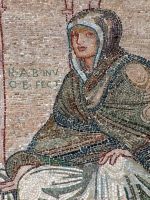 Mosaic figure for the Horniman Museum, by Robert Anning Bell.
Mosaic figure for the Horniman Museum, by Robert Anning Bell.
 Mosaic figure for the Horniman Museum, by Robert Anning Bell.
Mosaic figure for the Horniman Museum, by Robert Anning Bell.
Mosaics started with the ancient Greek pebble mosaics in black and white, but really flourished under the Romans, who made use of a variety of unglazed tiles and cut local stone to make colourful mosaics in flat, matt colours. Glassy mosaics (smalti) came into wide use in Byzantine times, had much brighter, glittery colours, and could also be made with gold backings. It is these two types – the encaustic tile matt mosaics descended from the Roman style, and the bright, shiny Italian smalti in the Byzantine style – which are generally found in Victorian and Edwardian architectural mosaics.
The Victorians were very fond of tile, which was used widely, including (though less so in London) as a facing for buildings – think of Manchester and Leeds. Later in the Victorian age, hard terra cotta, in deep or post-box red and various shades of pink, beige and white, was widely used. Making and cutting mosaic therefore was a natural part of the Victorian craftsman’s armoury. Such mosaics found particular use in doorways of stores, often advertising the store-owner, and there are still some of these to be found in London, though the move from recessed doorways to flat fronted shops has eliminated many. The use of mosaic on building frontages worked particularly well with a frieze setting, where monochromatic pictures in line could be made permanent through mosaic – in London, the Bethnal Green Museum (now the Museum of Childhood) has such a frieze, as does the Albert Hall. In late Victorian and Edwardian times, encaustic tile mosaics were found in arcades, typically to make bright, illustrative pictures of allegorical figures. We may also note a G. F. Watts oil painting (Time, Death and Judgement) rendered in mosaic, not particularly characteristically, in Roman style, in St Giles in the Fields off Tottenham Court Road. And another example of later encaustic ceramic mosaic is the memorial fountain in Old St Pancras Churchyard - see this page.
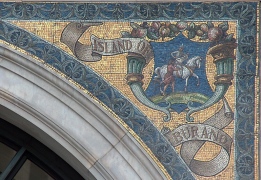 Spandrel mosaic by Salviati for his store, Regent Street.
Spandrel mosaic by Salviati for his store, Regent Street.
There is a nice story of how the more glittery Italian smalti mosaics came to England. When Venice was in the doldrums in the early 19th Century, one of the Mayors felt the best way to provide employment for the people was to revive old crafts, and demolish and rebuild the city in modern style. Fortunately, John Ruskin visited the town, and raised such a hue and cry around Europe that the demolition of Venice had to be abandoned, but he, and English colleagues, did appreciate something had to be done for local employment, and with their Venetian colleagues, came up with several famous Venetian crafts to revive, including glass and mosaics. Thus Venetian crafts were built up with British banks backing them, to produce wares for export back to Britain. The lead Italian mosaicist was Antonio Salviati, who revived the smalti mosaics of the middle ages – which had fallen out of production excepting the Vatican workshops, which were entirely for internal Catholic consumption – and according to plan, exported many of his wares to Britain. His store in London was at 235 Regent Street, where mosaics can still be seen on the frontage of what is now the Apple Store (see the Regent Street page).
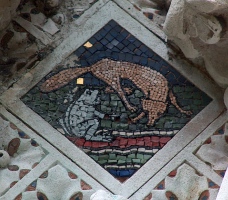
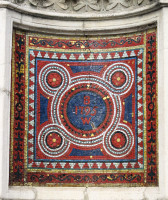 Small Venetian mosaic in London - Buxton and Marquis of Westminster memorials.
Small Venetian mosaic in London - Buxton and Marquis of Westminster memorials.
The Albert Memorial has the largest examples of Salviati mosaic in London, I would think (see pictures at bottom of this page, and all of them are shown on this page), along with the interior mosaics for St Paul’s Cathedal, for the Houses of Parliament, and in the Victorian and Albert Museum. Such Venetian mosaics were also used on a smaller scale on various outdoor memorials, such as the Buxton Memorial in Victoria Palace Gardens next to the Houses of Parliament, and the little Marquis of Westminster Fountain along Buckingham Palace Road close to Victoria Bus Station. We must also mention the large mosaic above the Chancel arch inside St James the Less, the splendid High Victorian Gothic church by the architect George Edward Street in Vauxhall Bridge Road, Westminster. G. F. Watts was the artist.
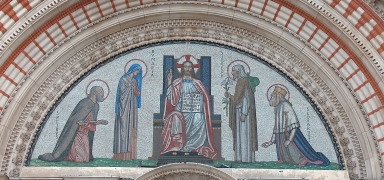
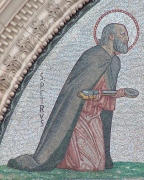 Robert Anning Bell's exterior mosaic for Westminster Cathedral, and detail of St Peter.
Robert Anning Bell's exterior mosaic for Westminster Cathedral, and detail of St Peter.
Around the turn of the century, the bright mosaic colours appealed to a new generation of artists, so that Robert Anning Bell’s beautiful mosaics appear inside and on the frontage of J. F. Bentley's Westminster Cathedral, and the same artist made the exterior mosaic for Harrison Townsend’s Horniman museum (see top of page). The Arts and Crafts artists also took mosaics into the churches, using them as minor decorations on funereal monuments, or occasionally making the whole monument in mosaic, as in the long series of mosaic monuments and decorations in St Mark’s Church, Maida Vale, West London, or the decorated chapel in St Stephen’s Rochester Row, Westminster, or the two pictures in St Martin in the Fields Church, Trafalgar Square. A pulpit mosaic is shown on the West Norwood Church page. Such monumental mosaics continued on until after the First World War, including several war memorials.
Overall then, while mosaics have never been greatly popular in architectural settings in Britain, they have found a niche for their jewel-like quality, preciousness and enrichment, and a way of providing durable colour in a climate where fresco never really stood much of a chance.
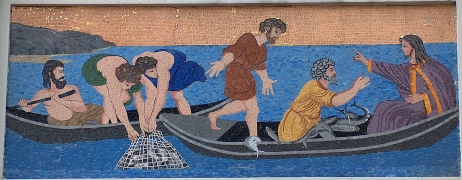
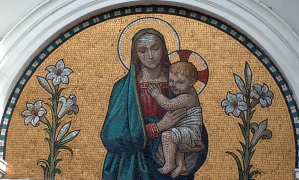 More modern religious mosaics.
More modern religious mosaics.
We may add as an addendum that in the 20th Century, mosaics have undergone periodic revivals, including a completely new usage of the medium by the Russian Boris Anrep (Bank of England, Tate Britain), and adoption by the Underground (pale pastel mosaics in Finsbury Park, and Paolozzi’s now much diminished work in Tottenham Court Road). We even see modern Catholic mosaic – and thus, we may guess, with some link at least in spirit to the Vatican mosaic workshops which kept the art alive through Medieval times –on the frontage to St Peter’s Italian Church in Clerkenwell, by Hatton Garden (picture above left).
Sample mosaic details from the Albert Memorial.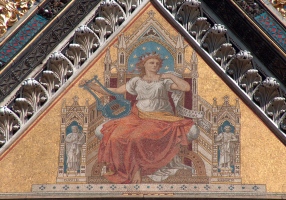
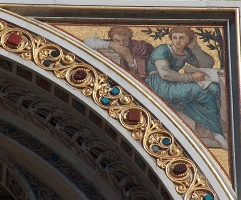
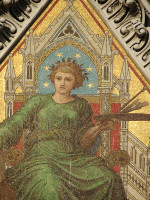
A building in Liverpool with mosaics // Architecture page // Sculptors
London Churches // London sculpture
Visits to this page from 13 Mar 2014: 10,936